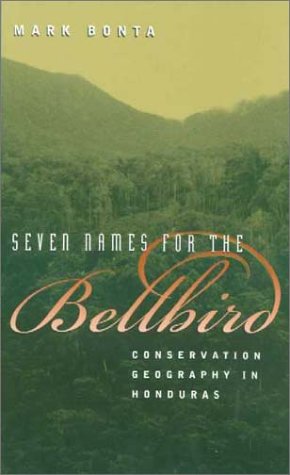
Dr. Mark Bonta, professor of Geography at Delta State University emerged first, the fearless and unabashed organizer of the excursion. Balding and newly middle-aged, he carried himself appropriately, a renowned 10-year-old Peace Corps alumni that could never quite escape his third world stomping grounds
The Aslan's Botaderos Jungle Adventure
08/03/02 Day 1
The truck filled with the team and all the supplies pulled up to the Gualaco rendezvous point only an hour and a half behind schedule. There was nothing unusual about that. What was out of place was the queer ensemble of enthused figures that piled out of the vehicle. Dr. Mark Bonta, professor of Geography at Delta State University emerged first, the fearless and unabashed organizer of the excursion. Balding and newly middle-aged, he carried himself appropriately, a renowned 10-year-old Peace Corps alumni that could never quite escape his third world stomping grounds. Julio and Don Jose were there too, two local area natives that seemed as exotic as anyone, the former with an ear-to-ear grin and a door-to-door cowboy hat and the latter a shoe-in for Fat Albert's "Mushroom Head" look alike, donning coke bottle glasses and a shiny silver metallic hardhat that leveled off somewhere below his nose. Julio had to crick his neck all the way back to see straight, but his one and a half toothed smile showed how undaunted the self-imposed handicap left him. Gualaco´s recently retired mayor was rarin' to go as well, though his disheveled hair and general confused expression suggested he was more ready to get back to bed after a midnight emergency bathroom break. Sam Wells stepped out of the truck like a movie star about to hit the red carpet on Oscar night. His grace and poise preceded his title of newly ordained doctor of Entomology from Colorado State University befittingly. His regal aura was suddenly shattered as he darted blindly out into the street with both hands waving in the air, his lanky body flailing maladroitly behind him, as if some private nightmare from the past lurking unexpectedly behind the closest adobe hut had finally caught up to him. He leapt into the air like a suicide and came back down with a closed fist His free hand pulled an alcohol filled vial out of his pocket and he exultingly dropped a copulating pair of sexually dimorphic bibionid march flies into it. So entered the motley crew's coup de grace: the full fledged, Far Side certified no holds barred bug expert. And then there was Clare and myself, of course, with whom there was nothing motley to decry, omitting perhaps our ruddy complexions, baggy, florid, thrift rack clothing, our mismatched, overstuffed back packs and the gaudy, unwieldy necklaces we wore that we sometimes refer to as binoculars. In short, we looked nothing at all like Miami-bound, senior citizen bus-adventure real estate tourists.
For the most part we were amassed and ready to rock. We all greeted and piled back into the truck and were off; our first assignment for the Botaderos excursion was soon ahead of us and Gualaco far behind. And with a merciless sun beating unrelentingly down on us from straight above, our week-long adventure had begun.
Day one was slated to be mild by any standards. It was really just a day trip into the field to do a bit of sleuthing about, a few relatively important scientific inquires burning to be answered. The subject in study: a class of plant called a cycad. As we can all recall from our basic college level biology course (yeah right), cycads were long sought as the missing link in the evolution between fern type plants and more advanced gymnosperms, or naked seed, pine cone-bearing greens. The mountainous slopes to the northwest of Gualaco are speckled with clandestine pockets of some of the last known healthy population of this particular cycad called teocintle. Fading fast due to slash-and-burn agriculture, cattle ranching, and other land "misuse" practices, this endemic species of die-hard, fire-resistant ancient survivor of an older world opens a small window into the distant past. In fact, many of the specimens we looked at had sprouted before Christ walked the Earth, being upwards of 2000 years old. Palm-like in gestalt, they were just as likely to be found twisting serpent-like along the grounds they were to be shooting traditionally up toward the sky. All in all, a hillside full of those things was highly reminiscent of a scene out of Dr. Suess' "Lorax" tale, as if a visit to the area inspired his artwork. Everything about them was grandiose. Many of the older ones measured beyond 10 meters (30ft) in length. The leaves were as sharp as knifes and as long as swords, and the female seed bearing pods weighed 40-50 pounds, akin to prize-winning, county fair, pinecone-like watermelons. The seeds nestled within were easily larger than golf balls. It was the female pod we were interested in. Hard to find due to their cultural harvesting as a source of dough for tamales, the search was on in order to determine what exactly was the pollinating agents that transported spores from the male plant to the female.
We spent much of the morning hunting fruitlessly for any pod at all, a necessary preliminary to discovering what pollinators might be busy inside. Meanwhile we watched birds and took photos and curiously stared at Sam leaping through the brush with a butterfly net in one hand and an aptly named "beat net" in the other, which he would place under the foliage while beating the branches to shake unsuspecting insects off of their dining pad and into a new life as University taxonomic closet shelf-decorators.
Eventually we happened across a female teocintle that hadn't had its humbler-than-average sized pod head decapitated yet. Carefully navigating through the razor sharp swords that protected it, we were all very excited to find bugs swarming throughout its surface. Sam was called over and he gathered several specimens with an enigmatic, concentrated expression before proclaiming in a historical tone, "It's a type of weevil, and it's a new species to science."
Photos and notes were taken and we all eventually left the "typical site" to itself, feeling a bit high and a bit important. It was a great moment to have shared. There is yet, of course, to reassure the weevil's claim to unfamiliarity in the lab, but barring any unexpected conclusions, one of those little guys is destined to become the "type specimen", or Smithsonian Institute's collection individual against which all future collections of similar weevils will be compared.
So was the successful conclusion to the trip's initial objective. It was time to return back to Gualaco for a solid night's rest before proceeding with the bulk of our work. The next day would bring with it our main task: a journey into the virgin wild lands of the prospective protected area known as Las Montañas de Botaderos, an unusually large expanse of untapped, unknown wilderness bulging at the seams with infinite possibilities of scientific and human interest. Next stop: maybe not Conrad´s heart of darkness itself, but a good gall bladder of obscurity nonetheless.

